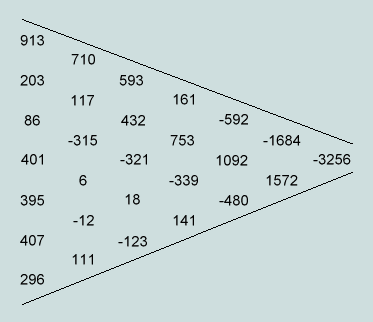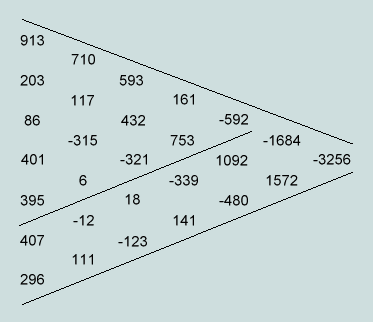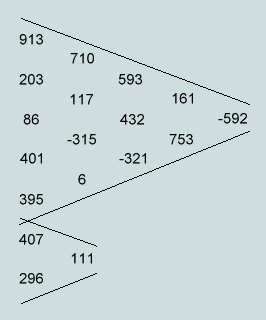
A SUBSTANTIAL DIFFERENCE
Another view of the miracle that is Genesis 1:1
1. Introduction
It turns out that the seemingly mundane observation that 37 uniform circular counters resting on a flat surface may be grouped together to form any one of three distinct symmetrical figures (Appendix 1) has far-reaching consequences. Most obviously, (1) because thirty-seven is unique in respect of this absolute universal attribute, (2) because of its presence as factor in each component of the Creator's name - as delivered in NT Greek, (3) because it is found in abundance among the 7 Hebrew words of the Bible's first verse, and (4) because it is highest prime factor of the unique triangular number, 666. Indeed, the whole speaks eloquently of intelligent selection, design and purpose. Many additional evidences to support this conclusion have been offered in earlier pages; these have largely focused on matters arising from sums of the word characteristic values (or CVs, ie the numbers arising from a fair alternative reading of the words) - in particular, the coordinated numerical geometries - and it has been argued that these remarkable features combine to point conclusively to the emergence from the Judeo-Christian Scriptures of what may fairly be described as a standing miracle.
Our purpose here is to extract further attributes of the miracle by examining word CV differences, and related matters. These suggest beyond all doubt that the Genesis 1:1 number set is indeed an exceedingly rare and _precisely-ordered structure_ - one that has, undoubtedly, been so fabricated as to maximise its already closely-knit associations.
2. Progressive differencing
The following diagram depicts a form of finite differencing - a simple procedure familiar to numerical analysts - involving, in this case, the 7 word CVs of the opening verse of the Judeo-Christian Scriptures.

The leftmost column of figures - reading from top to bottom - represents the familiar Genesis 1:1 number set. Each entry in succeeding columns is derived from the two figures that appear on its immediate left - subtracting the lower from the upper. Thus, in the second column, 710 = 913-203; -315 = 86-401; and so on.
Ignoring the negative sign, the ultimate result of this process (an outcome to which _all_ members of the Genesis 1:1 data set have contributed in equal measure) is 3256 (= 88 x 37) which happens to be the LCM (lowest common multiple) of the two final values of the set, viz 407 and 296. This result is certainly very interesting, and on closer inspection is seen to be equivalent to the vector multiplication of this set by the 7th row of a form of Pascal's triangle. This is explained in Appendix 2.
Interestingly, the sum of -3256 and 2701 (the triangular sum of the same 7 values) is -555. Of interest also is the result of successively differencing the first 5 of the 7 (representing the 'supernatural' component of the verse - their sum appearing geometrically as three satellite triangles, each of 666).

The outcome is shown in context to be -592. Again, ignoring the negative sign, this is seen to be 16 x 37, or 2 x 296 (the 7th term of the Gen.1:1 set). That of its complement (words 6 and 7 - each a multiple of 37) is 111, or 3 x 37.
The following diagram summarises these two latter outcomes in context.

These related multiples of 37 - a number already found to be a prominent feature of this verse - suggest that the order of these CVs is also significant. That this is indeed the case is demonstrated in Appendix 3 where, of the 5040 possible permutations of these 7 numbers, the biblical arrangement is 1 of only 4 that display features that are completely consistent with earlier observations, and of these, the original arrangement alone is of particular interest.
3. Alternative vector multipliers
The concept of forming the sum of the products of the Genesis 1:1 CVs and the corresponding terms of a symmetrical vector (viz a row of the modified Pascal triangle), suggests there may be other structures to which this verse is equally resilient in respect of generating a multiple of 37 in this manner. Two examples are given.
The first concerns symmetical vectors of the form {A,B,C,D,C,B,A) in which A,B,C,D are in arithmetic progression (Appendix 4). For example, if we take any number as the first term (A = -7, say), and any number as common difference (B-A = C-B = D-C = 5, say), then the particular vector becomes {-7, -2, 3, 8, 3, -2, -7} and applying this to Genesis 1:1, as described:
(-7.913) + (-2.203) + 3.86 + 8.401 + 3.395 + (-2.407) + (-7.296) = -5032 = -136.37
- [Observe that the embedded dot here signifies 'multiplied by']
The second concerns the asymmetrical vector comprising the first 7 triangular numbers, {1,3,6,10,15,21,28}. Here is the calculation:
1.913 + 3.203 + 6.86 + 10.401 + 15.395 + 21.407 + 28.296 = 28808 = 2^3.13.277 = 8.3601
4. Other features that speak of precise order
Divided by 3, 913 delivers the remainder 1, whereas each of the remaining 6 deliver the remainder 2.
If the 7 word CVs of Genesis 1:1 are regarded as single digits in a number system, radix 1000, then the number thus represented is the concatenation of these CVs, and it factorises thus:
913203086401395407296 = 2^6 x 7 x 37 x 131 x 1291 x 4159 x 7879 x 9941
[Observe that to achieve conformity of expression, 86 - the only 2-digit CV - is represented here as 086]
This result is particularly interesting for two reasons: (a) 2368 (ie 64 x 37) is a factor - this being the CV of the Greek form of the name "Jesus Christ", nominative case - and since the claim is made (eg Jn.1:1-3, 10) that he is our Creator (ie the 'God' of Genesis 1:1), the matter is potentially significant; and (b) the fact that it has 13 prime factors - the largest having only 4 digits - is indicative of low probability* and hence of design.
Only 120 of the 5040 concatenated arrangements of the 7 CVs are exactly divisible by 2368 - all of which are required to end with words 6 and 7 in situ. One final observation concerns the concatenation of these, viz 407296, which factorises thus: 2 x 86 x 2368. Since the related words are translated "and the earth", and 86 happens to be the CV of word 3 ('God'), the association of these numbers strongly suggests that Jesus Christ is, indeed, God Incarnate!
*The probability of the concatenated Genesis 1:1 number factorising to have all factors < 10,000 has been calculated by computer simulation to be of the order of 1 in 35,000.
Dividing the 7 CVs into the sums of 'odds' and 'evens' leads to compelling symmetrical representations of the verse. The details may be found here.
5. The matter of probabilities
The Hebrew words of the Torah (or Pentateuch) number 79,976. In a computer simulation sets of 7 were chosen randomly and tested for the foregoing properties:
The observed probabilities are shown bracketed.
On this basis alone the Genesis 1:1 set represents a 1.5 million to 1 longshot. This is lifted beyond 200 million to 1 when the AP multiplication requirement is included.
6. Conclusions
It might well be supposed that a multiple of some number N - representing the sum of 7 individual components - must yield another multiple of N when the same set of 7 is progressively differenced (Appendix 5). This assumption is clearly incorrect, and it follows that the persistence of the unique number 37 as factor (a feature that is here closely dependent on the ordering of the words) provides further reasons (if any more were needed!) for believing the opening verse of the Judeo-Christian Scriptures to be far more than a powerful and foundational assertion; in addition, it is undoubtedly a wonderfully designed numerical artefact, solidly linked with the Creator's name!
As we contemplate the many facets of this standing miracle the word that strongly comes to mind is PURPOSE! Why should the Lord, from the beginning, have built these numerical features into His Word? Why have they remained hidden until now? And why are they proving to be so unpopular - particularly among those who, by definition, are lovers of truth? I suspect that such intriguing questions - and more - must soon be answered.
Vernon Jenkins MSc
2007-06-03